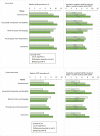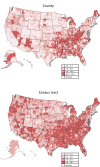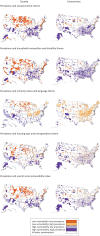Linking Local-Level Chronic Disease and Social Vulnerability Measures to Inform Planning Efforts: A COPD Example
- PMID: 37651645
- PMCID: PMC10487786
- DOI: 10.5888/pcd20.230025
Linking Local-Level Chronic Disease and Social Vulnerability Measures to Inform Planning Efforts: A COPD Example
Abstract
Introduction: Data are publicly available to identify geographic differences in health outcomes, including chronic obstructive pulmonary disease (COPD), and social vulnerability; however, examples of combining data across sources to understand disease burden in the context of community vulnerability are lacking.
Methods: We merged county and census tract model-based estimates of COPD prevalence from PLACES (www.cdc.gov/PLACES) with social vulnerability measures from the Centers for Disease Control and Prevention/Agency for Toxic Substances and Disease Registry Social Vulnerability Index (https://www.atsdr.cdc.gov/placeandhealth/svi), including 4 themes (socioeconomic, household composition and disability, minority status and language, and housing type and transportation), and the overall Social Vulnerability Index (SVI). We used the merged data set to create vulnerability profiles by COPD prevalence, explore joint geographic patterns, and calculate COPD population estimates by vulnerability levels.
Results: Counties and census tracts with high COPD prevalence (quartile 4) had high median vulnerability rankings (range: 0-1) for 2 themes: socioeconomic (county, 0.81; tract, 0.77) and household composition and disability (county, 0.75; tract, 0.81). Concordant high COPD prevalence and vulnerability for these themes were clustered along the Ohio and lower Mississippi rivers. The estimated number of adults with COPD residing in counties with high vulnerability was 2.5 million (tract: 4.7 million) for the socioeconomic theme and 2.3 million (tract: 5.0 million) for the household composition and disability theme (high overall SVI: county, 4.5 million; tract, 4.7 million).
Conclusion: Data from 2 publicly available tools can be combined, analyzed, and visualized to jointly examine local COPD estimates and social vulnerability. These analyses can be replicated with other measures to expand the use of these cross-cutting tools for public health planning.
Figures



Similar articles
-
Association of County-degree Social Vulnerability with Chronic Respiratory Disease Mortality in the United States.Ann Am Thorac Soc. 2023 Jan;20(1):47-57. doi: 10.1513/AnnalsATS.202202-136OC. Ann Am Thorac Soc. 2023. PMID: 36044720
-
Social Vulnerability and Premature Cardiovascular Mortality Among US Counties, 2014 to 2018.Circulation. 2021 Oct 19;144(16):1272-1279. doi: 10.1161/CIRCULATIONAHA.121.054516. Epub 2021 Oct 18. Circulation. 2021. PMID: 34662161
-
Social vulnerability index and age-adjusted mortality from all causes by county: Mississippi 2016-2020.J Natl Med Assoc. 2024 Jun;116(3):302-308. doi: 10.1016/j.jnma.2024.05.003. Epub 2024 May 20. J Natl Med Assoc. 2024. PMID: 38772793
-
Comparison of National Vulnerability Indices Used by the Centers for Disease Control and Prevention for the COVID-19 Response.Public Health Rep. 2022 Jul-Aug;137(4):803-812. doi: 10.1177/00333549221090262. Epub 2022 May 5. Public Health Rep. 2022. PMID: 35514159 Free PMC article. Review.
-
Social Vulnerability and Location of Death in Heart Failure in the United States.Curr Probl Cardiol. 2023 Jul;48(7):101689. doi: 10.1016/j.cpcardiol.2023.101689. Epub 2023 Mar 10. Curr Probl Cardiol. 2023. PMID: 36906162 Review.
Cited by
-
Comprehensive analysis of vulnerability status and associated affect factors among prehospital emergency patients: a single-center descriptive cross-sectional study.Front Public Health. 2024 Feb 29;12:1330194. doi: 10.3389/fpubh.2024.1330194. eCollection 2024. Front Public Health. 2024. PMID: 38487181 Free PMC article.
-
Outpatient Versus Inpatient Total Joint Arthroplasty: Do Medically and Socially Complex Patients Require More Resources but Achieve Similar Outcomes?Arthroplast Today. 2025 Feb 11;32:101631. doi: 10.1016/j.artd.2025.101631. eCollection 2025 Apr. Arthroplast Today. 2025. PMID: 40026483 Free PMC article.
-
Community-Level Social Vulnerability and Hip and Knee Joint Replacement Surgery Receipt Among Medicare Enrollees With Arthritis.Med Care. 2024 Dec 1;62(12):830-839. doi: 10.1097/MLR.0000000000002068. Epub 2024 Oct 4. Med Care. 2024. PMID: 39374183 Free PMC article.
-
Socioeconomic status and sleep duration among a representative, cross-sectional sample of US adults.BMC Public Health. 2024 Dec 18;24(1):3410. doi: 10.1186/s12889-024-20977-w. BMC Public Health. 2024. PMID: 39695529 Free PMC article.
-
Social Determinants of Health and Health-Related Social Needs Among Adults With Chronic Diseases in the United States, Behavioral Risk Factor Surveillance System, 2022.Prev Chronic Dis. 2024 Nov 27;21:E94. doi: 10.5888/pcd21.240362. Prev Chronic Dis. 2024. PMID: 39602222 Free PMC article.
References
-
- US Department of Health and Human Services, Office of Disease Prevention and Health Promotion. Healthy People 2030: social determinants of health. Accessed January 5, 2023. https://health.gov/healthypeople/objectives-and-data/social-determinants...
-
- National Academies of Sciences, Engineering, and Medicine. Integrating social care into the delivery of health care: moving upstream to improve the nation’s health. Washington, DC: National Academies Press, 2019. - PubMed
-
- World Health Organization, Commission on Social Determinants of Health. Closing the gap in a generation: health equity through action on social determinants of health; 2008. - PubMed
MeSH terms
LinkOut - more resources
Full Text Sources
Medical

